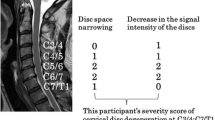Abstract
The concentration of zinc, copper, selenium, albumin, and ceruloplasmin in blood plasma and the activity of superoxide dismutase and glutathione peroxidase in erythrocytes were determined in a set of patients with idiopathic scoliosis (n=51). A significant decrease of selenium concentration (0.50±0.16 µmol/L) was found when compared with a control group (0.69±0.07 µmol/L) (p<0.01). The same levels of significance were found out for selenium levels corrected for albumin content. In a group of patients with a curvature over 45° indicated for a surgical correction, the average plasma concentrations of selenium were significantly lower (p<0.05) in comparison with a group of patients with a curvature below 45° treated conservatively.
The GSH-Px activity in erythrocytes was the same in both sets. In comparison with the controls, no significant differences were revealed in all of the other parameters. The detection of the decreased blood plasma concentration of selenium has suggested possible disturbance of well-proportioned distribution and of general optimal availability of selenium in the organism of patients with idiopathic scoliosis with likely effects on the process of synthesis and maturation of collagen affecting the axial skeleton stability.
Similar content being viewed by others
References
T. S. Renshaw, Idiopathic scoliosis in children, Curr. Opin. Pediatr. 5, 407–412 (1993).
A. G. Veldhuizen, D. J. Wever, and P. J. Webb, The aetiology of idiopathic scoliosis: biomechanical and neuromuscular factors, Eur. Spine J. 9, 178–184 (2000).
J. W. Roach, Adolescent idiopathic scoliosis, Orthop, Clin. North Am. 30, 353–365 (1999).
T. G. Lowe, M. Edgar, J. Y. Margulies, N. H. Miller, V. J. Raso, K. A. Reinker, et al., Etiology of idiopathic scoliosis current trends in research, J. Bone Joint Surg. Am. 82, 1157–1168 (2000).
R. Savini, S. Cervellati, and E. Beroaldo, Spinal deformites in Marfan’s syndrome, Ital. J. Orthop. Traumatol. 6, 19–40 (1980).
K. N. Joseph, H. A. Kane, R. S. Milner, N. L. Steg, M. B. Williamson, Jr., and J. R. Bowen, Orthopedic aspects of the Marfan phenotype, Clin. Orthop. 277, 251–261 (1992).
K. J. Lipscomb, J. Clayton-Smith, and R. Harris, Evolving phenotype of Marfan’s syndrome, Arch. Dis. Child. 76, 41–46 (1997).
E. D. Harris, J. K. Rayton, J. E. Balthrop, R. A. DiSilvestro, and M. Garcia-de-Qevedo, Copper and the synthesis of elastin and collagen, Ciba Found. Symp. 79, 163–182 (1980).
R. K. Vadlamudi, R. J. McCormick, D. M. Medeiros, J. Vossoughi, and M. L. Failla, Copper deficiency alters collagen types and covalent cross-linking in swine myocardium and cardiac valves, Am. J. Physiol. 264, H2154-H2161 (1993).
R. G. Brown, P. R. Sweeny, and E. T. Moran Jr, Collagen levels in tissues from selenium deficient ducks, Comp. Biochem. Physiol. A 72, 383–389 (1982).
P. R. Sweeny and R. G. Brown, Ultrastructural studies of the myotendonous function of selenium-deficient ducklings, Am. J. Pathol. 100, 481–496 (1980).
M. M. Walser, V. C. Morris, and O. A. Levander, Effect of dietary selenium on the development of Fusarium-induced tibial dyschondroplasia in broiler chikens, Avian Dis. 32, 84–88 (1988).
A. Peng, C. Yang, H. Rui, and H. Li. Study on the pathogenic factors of Kashin-Beck disease, J. Toxicol. Environ. Health 35, 79–90 (1992).
C. L. Yang, M. Bodo, H. Notbohm, A. Peng, and P. K. Muller, Fulvic acid disturbs processing of procollagen II in articular cartilage of embryonic chicken and may also cause Kashin-Beck disease, Eur. J. Biochem. 202, 1141–1146 (1991).
S. Meret and R. I. Henkin, Simultaneous direct estimation by atomic absorption spectrophotometry of copper and zinc in serum, urine and cerebrospinal fluid, Clin. Chem. 17, 369–373 (1971)
E. Rothery, Analytical methods for graphite tube atomizers, VARIAN, No.85-100848-00 (1988).
B. Pohl, Determination of normal levels of selenium in blood serum by GFAAS, Varian, AA-103 (1991).
C. Yang, C. Niu, M. Bodo, E. Gabriel, H. Notbohm, E. Wolf, and P. K. Muller, Fulvic acid supplementation and selenium deficiency disturb the structural integirty of mouse skeletal tissue. An animal model study the molecular defects of Kashin-Beck disease, Biochem. J. 289, 829–835 (1993).
L. Q. Xu, W. X. Sen, Q. H. Xiong, H. M. Huang, and P. Schramel, Selenium in Kashin-Beck disease areas, Biol. Trace. Element Res. 31, 1–9 (1991).
C. Yang, E. Wolf, K. Roser, G. Delling, and P. K. Muller, Selenium deficiency and fulvic acid supplementation induces fibrosis of cartilage and disturbs subchondral ossification in knee joints of mice: an animal model study of Kashin-Beck disease, Virchows Arch. A Pathol. Anat. Histopathol. 423, 483–491 (1993).
V. Korunova, Z. Skodova, J. Dedina, Z. Valenta, J. Parizek, and Z. Pisa, Serum selenium in adult Czechoslovak (central Bohemia) population, Biol. Trace Element Res. 37(2–3), 91–99 (1993).
Author information
Authors and Affiliations
Rights and permissions
About this article
Cite this article
Dastych, M., Cienciala, J. Idiopathic scoliosis and concentrations of zinc, copper, and selenium in blood plasma. Biol Trace Elem Res 89, 105–110 (2002). https://doi.org/10.1385/BTER:89:2:105
Received:
Revised:
Accepted:
Issue Date:
DOI: https://doi.org/10.1385/BTER:89:2:105



